AMD Radeon 6670, 6570 & 6450 Review
Sixteen months ago we looked at the Mainstream segment from the Radeon 5000 series. This looked at the low-end segment in that product family, specifically the Radeon HD 5670, HD 5550 and HD 5450. My "final thoughts" in that review was, "If you have any interest in Eyefinity, or game in anything more than a cursory fashion, I would recommend the upgrade to the 5700-series. The one downside of the 5700-series is that it does require a power connection from the PSU. It would be nice to get the 5700-series performance in low-power card. Maybe next generation".
With the Radeon HD 6000 series, we're now in that "next generation", and we can now see if we can get solid 1080p gaming from a card that doesn't require an external power connection.
Architecture & Specs
The Mainstream segment has significantly smaller feature sets, Shaders, transistor counts and power draws. None of the cards in the Mainstream segment require additional power from the PSU.
Below is a spec block with outlining the specs from the Radeon 6790 all the way through the 5450. I've also included specs for two of AMD's new APUs, which have graphics cores that fall within the Mainstream specs.
| Card | GPUs | Transistors | Memory | Shaders | Clock (MHz) | TDP (Watts) | MSRP* | ||
| Core | Mem | Idle | Max | ||||||
| AMD Radeon HD 6790 | 1 | 1.7B | 1GB | 800 | 840 | 1050 | 19 | 150 | $149 |
| AMD Radeon HD 6670 | 1 | 716M | 1GB | 480 | 800 | 1000 | 12 | 66 | $99 |
| AMD Radeon HD 6570 | 1 | 716M | 512MB | 480 | 650 | 900 | 10 | 44 | $79 |
| AMD A8-3850 APU (HD 6550) | 1 | 1GB | 400 | 600 | 800 | 100W (APU Total) | $134 | ||
| AMD Radeon HD 6450 | 1 | 370M | 512MB | 160 | 750 | 900 | 9 | 27 | $54 |
| AMD E-350 APU (HD 6310) | 1 | 1GB | 80 | 492 | 533 | 18W (APU Total) | OEM | ||
| ATI Radeon HD 5770 | 1 | 1.04B | 1GB | 800 | 850 | 1200 | 18 | 108 | $129 |
| ATI Radeon HD 5750 | 1 | 1.04B | 1GB | 720 | 700 | 1150 | 16 | 86 | $134 |
| ATI Radeon HD 5670 | 1 | 627M | 1GB | 400 | 775 | 1000 | 14 | 61 | $109 |
| ATI Radeon HD 5550 | 1 | 627M | 1GB | 320 | 550 | 800 | 9 | 40 | $74 |
| ATI Radeon HD 5450 | 1 | 292M | 1GB | 80 | 650 | 800 | 6.4 | 19 | $54 |
Installation & Comparison
Here are two pics showing the HD 6670 and HD 6570 installed next to an HD 6970. Both low-profile cards are diminutive next to the flagship single-GPU card.
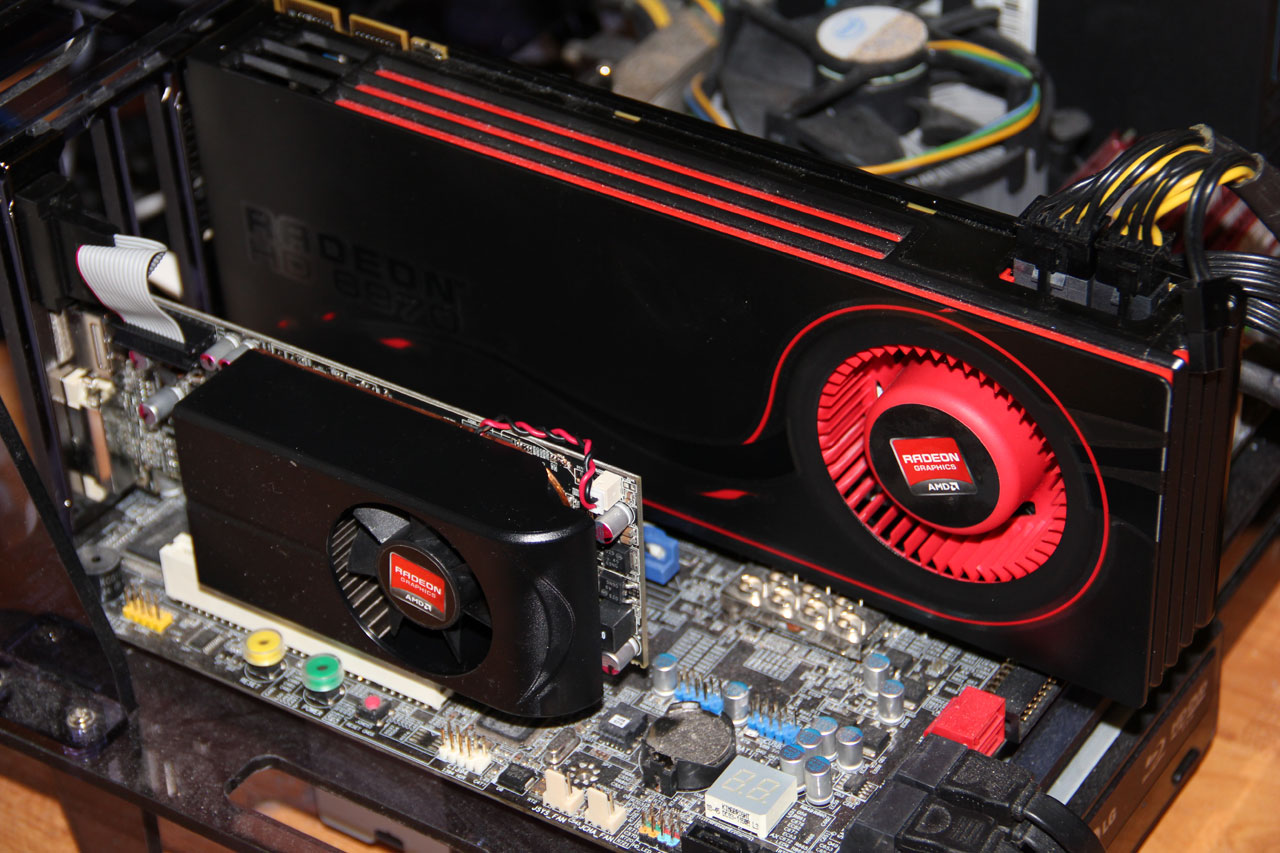
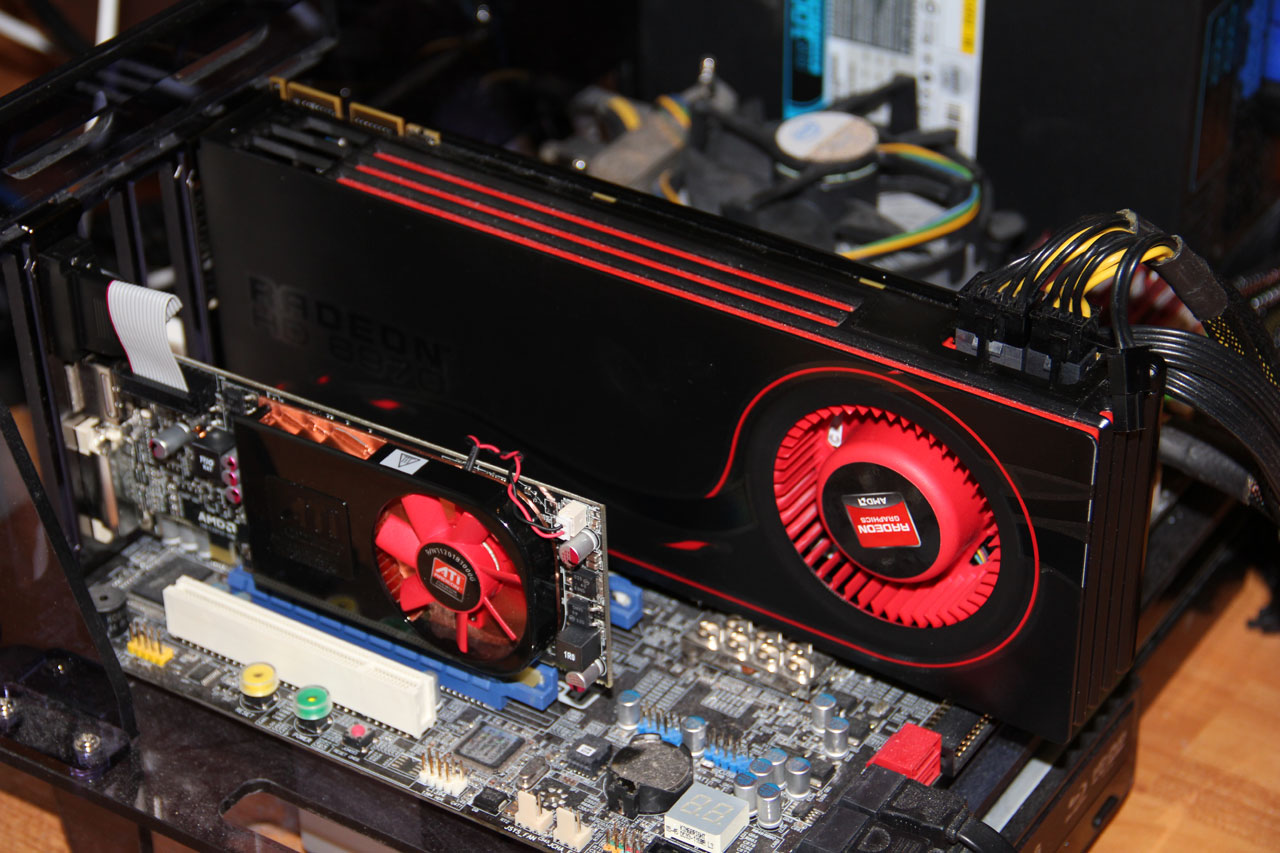
Note
I've decided to try opening comments on this review, to see how it goes. Comments will only be visible on the first page.
AMD Radeon 6670, 6570 & 6450 Review - Benchmarking
Setup & Installation
Each of these reference cards offer a consistent set of connections - 1x VGA, 1x DisplayPort, and 1x DVI. Due to the small form factor of the cards, they can fit in tight spaces. None of these cards require an external power connection.
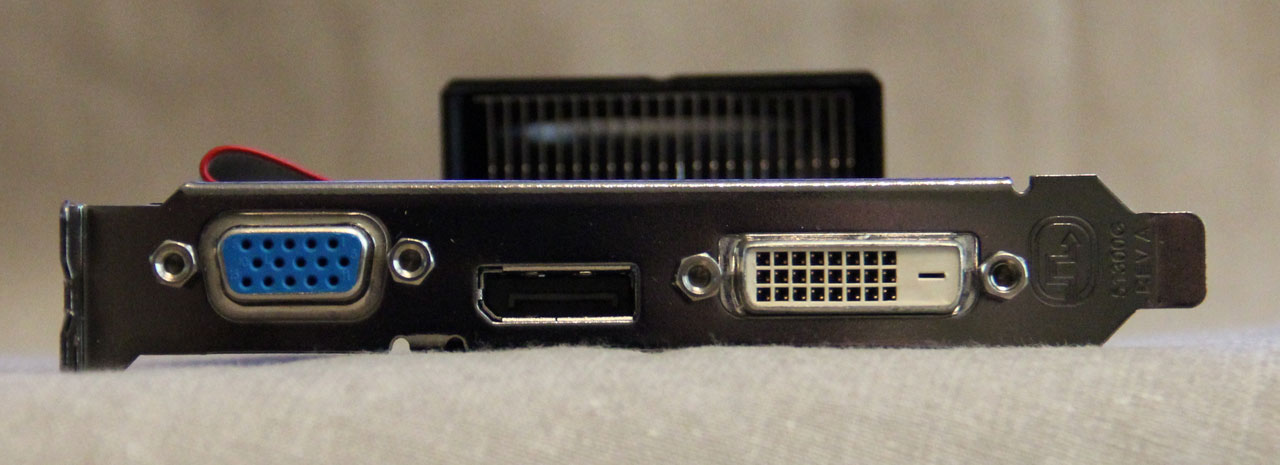
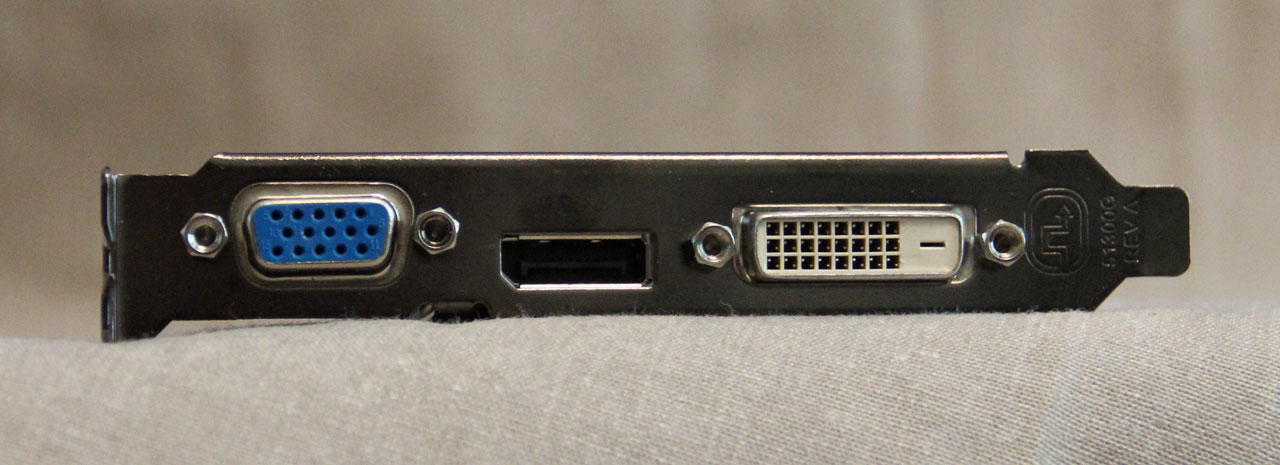
System Specs
Tests were done with the 11.10 Driver, on my existing test bed. The E-350 was tested with 4GB of RAM (with 1GB allocated to the GPU). The A8-3850 had 8GB of RAM (with 1GB allocated to the GPU).
- Windows 7 SP-1
- EVGA X58 Tri-SLI Motherboard
- Intel i7 920 at 4x2.67GHz
- 12GB G.Skill DDR3 RAM
- 2x Samsung 320GB T-Series HDD (one for the OS and games; one for swap file and FRAPS)
- LG Super Multi Blu (HD-DVD/Blu-Ray Player)
- Onboard audio
- Corsair HX1000
- My Open PC Doma Pro PCI Case
- Logitch K340 Keyboard & Performance MX Mouse
- Ergotech Heavy Duty Triple Desk Stand
- Dell U2211H IPS 16:9 1920x1080 Display
Hardware Tested
I only have AMD hardware tested for comparison in this review. This is not for lack of wanting to test NVIDIA hardware in Surround, but NVIDIA has not yet decided to support the WSGF with hardware for review and benchmarking. Considering that the WSGF is a hobby that just supports itself, I cannot justify spending the money needed to test NVIDIA cards.
Most of my time is spent working on the site (or other projects), and much of my "play time" is spent benchmarking. Cards would basically only be used for testing, and I cannot reconcile purchasing cards that would only be used for testing. It's simply not a good ROI.
Resolutions Tested
I tested both 1600x900 and 1920x1080 in widescreen.
Games Tested
My game selection remains unchanged since the HD 6990 benchmarks.
- Aliens vs. Predators
- Battle Forge
- DiRT 2
- F1 2010
- Far Cry 2
- HAWX (only at 2xAA)
- Heaven 2 (DX9, DX10 & DX11)
- Just Cause 2
- Mafia II
- S.T.A.L.K.E.R. - Call of Pripyat Benchmark Tool
As always, all games are tested at max settings (unless otherwise noted), with 4xAA and 16xAF enabled. We tested some of these titles as part of our review of the Mainstream 5000-series cards. Where available, we include these numbers as well.
I have simplified the graphs to only include cards of similar performance. It really doesn't do any good to see the massive performance increase in a Radeon HD 6990 as it's not comparable to any of the Mainstream cards we are testing here.
Simplifying the graphs made them much more readable and user friendly.
Future Testing
I am finishing a full test and review of the AMD A8-3850 APU, and that should be posted within the next week.
AMD Radeon 6670, 6570 & 6450 Review - Aliens vs. Predator, Battle Forge & DiRT 2
Aliens vs. Predator
Aliens vs. Predator (AvP) is an FPS title from Rebellion Studios. It allows players to take on the role of either an Alien, a Predator or a human space marine. While the title received mixed reviews, it is a DX11 graphics powerhouse that can bring many machines to their knees.
The demo follows a number of Alien creatures, and makes extensive use of shaders and tessellation. The mainstream cards obviously don't stand up to the AvP demo, and honestly I don't expect them to. It is a difficult demo that is made to stress even high-end cards.
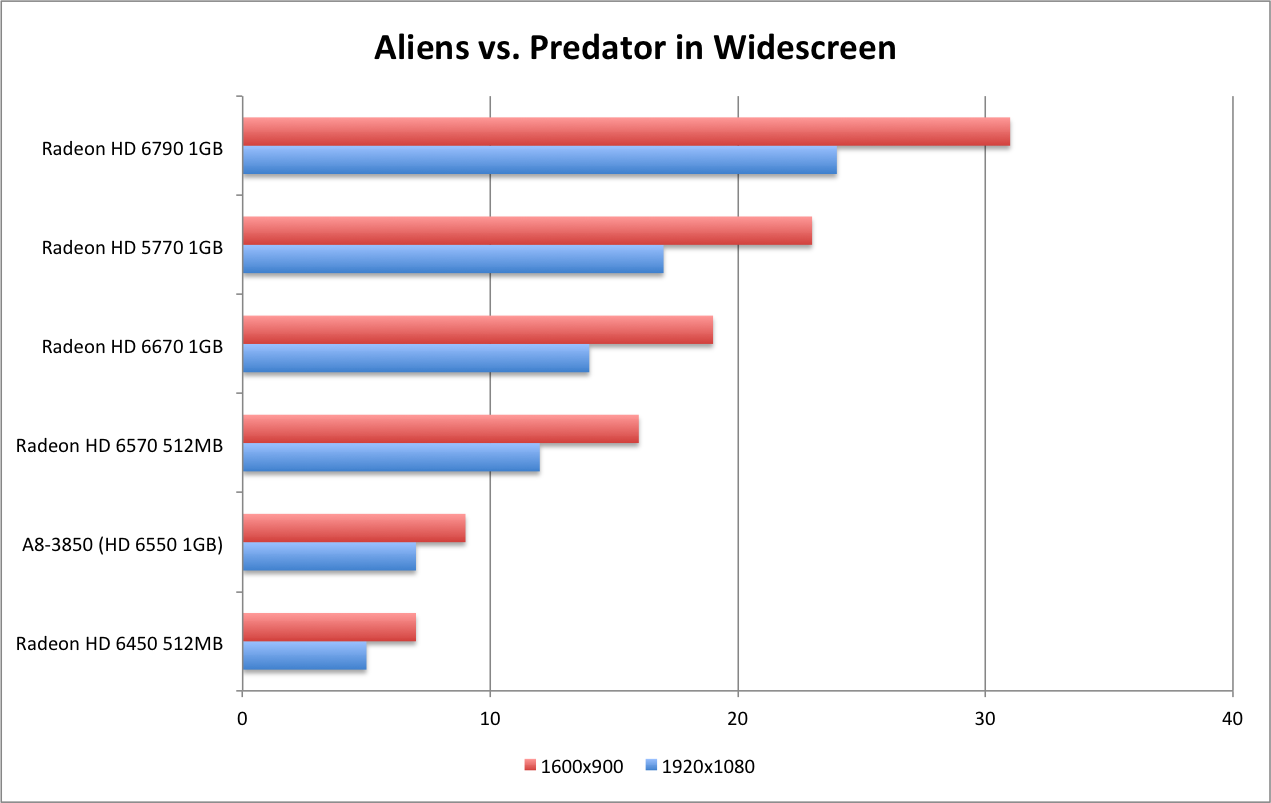
Battle Forge
Battle Forge is the free-to-play RTS from Electronic Arts. It offers a steampunk/fantasy RTS experience, where armies are build based on "decks" of cards similar to the Magic: The Gathering card game.
Battle Forge is one of AMD's spotlight (my terminology) games, as it offers both DX11 and proper Eyefinity support. The game offers a number of DX11 features, and a wealth of options for tuning performance. Specifically, Battle Forge uses DX11 and Shader Model 5.0 to compute HighDefinition Ambient Occlusion (HDAO). For our tests we maxed out all of the settings and forced DX11 through the config.xml file.
None of the cards tested crosses the 30fps threshold at max settings. However, we do see strong improvements between the 5000-series and their 6000-series equivalent. The HD 5450 wouldn't run the title at 1080p, while the HD 6450 does push through at almost 10fps. The HD 6550 equivalent in the A8 APU adds a couple of fps over the 5550, and the HD 6670 adds about 20% over its previous counterpart. While this peformance won't win any awards with the typical WSGF user, the HD 6670 posts this improved performance while also consuming 25% lower and costing $35 less than the HD 5670.
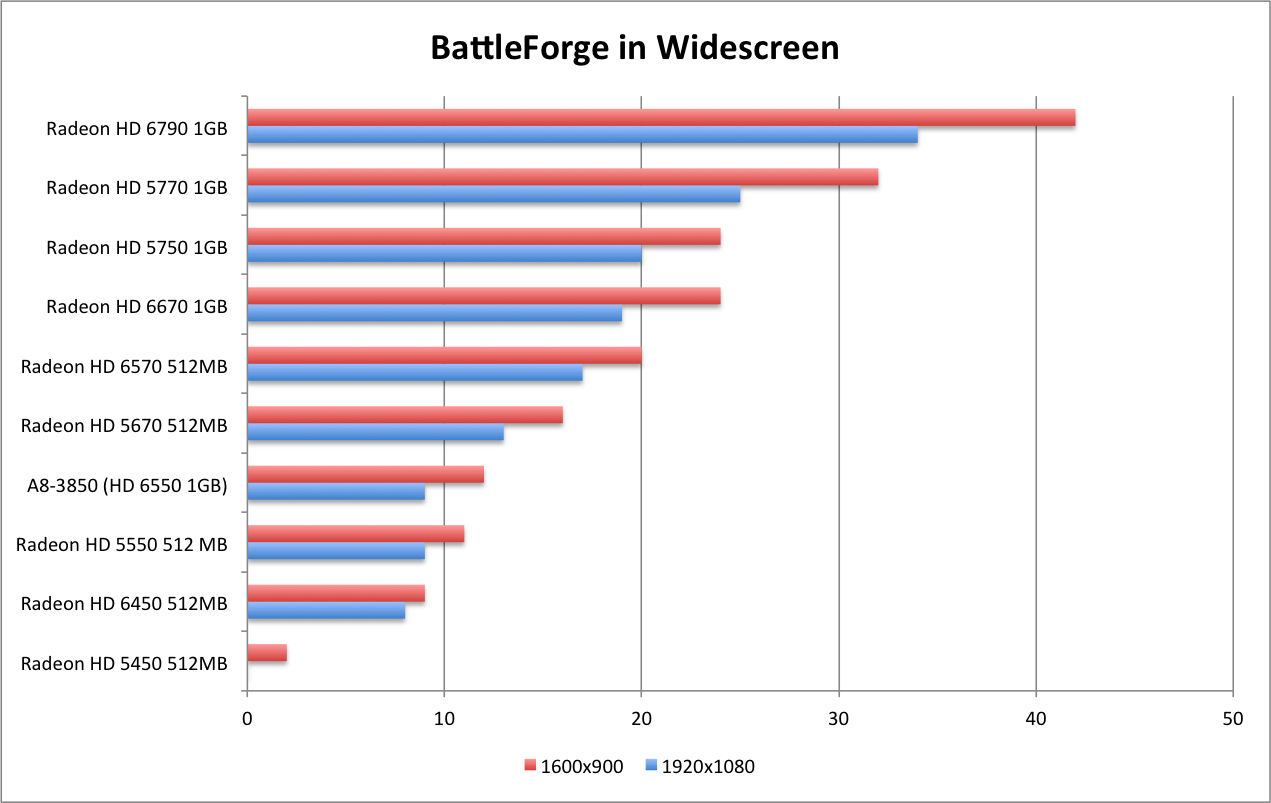
DiRT 2
Dirt 2 is the second iteration of the Dirt rally racing series from Codemasters. Like Battle Forge, Dirt 2 is a spotlight game for AMD. Like Battle Forge it offers proper Hor+ gameplay in Eyefinity and DX11 support. Unless the user goes into the "hardware_settings_config.xml" file and forces DX9, Dirt 2 runs in DX11 mode. Unfortunately Dirt 2 does not offer a DX10 mode. This is unfortunate, as many games show improved performance when running in DX10 vs. DX9.
The true (noticeable) DX11 features come in to play based on the user settings in the in-game graphics options. Several key features are the "Hardware Tessellated Dynamic Water" (achieved through "Ultra" quality water), "Hardware Tessellated Dynamic Cloth" (achieved through "High" quality cloth), and DX11 Accelerated HDAO (through "High" quality HDAO).
The DX11 water and cloth offer more realistic geometry and movement. The DX11 water produces actual waves in deep puddles (as the player drives through), rather than simple "swirls" in the texture surface. The DX11 cloth offers more realistic ripples and waves in the cloth material over the DX9 version. On the other hand, the DX11 HD Ambient Occlusion (HDAO) offers an accelerated computation path.
DX11 doesn't necessarily provide earth-shaking changes to gameplay. But, it provides more realistic "movement" in the world's objects - cloth, water, grass, etc. While a DX9 or DX10 game is perfectly enjoyable, the DX11 technology offers better immersion by making the "little things" more lifelike. Additionally, it offers better computation paths through increased parallelism (and better computation paths for DX10), much like DX10 offered better performance (over DX9) in games such as Far Cry 2.
The HD 6000 cards show similar gains in Dirt 2 as they do in Battle Forge. Even the HD 6450 almost hits playable rates at max settings. The HD 6570 pushes past 30fps at both 1600x900 and 1080p, all for less than 45W and $80.
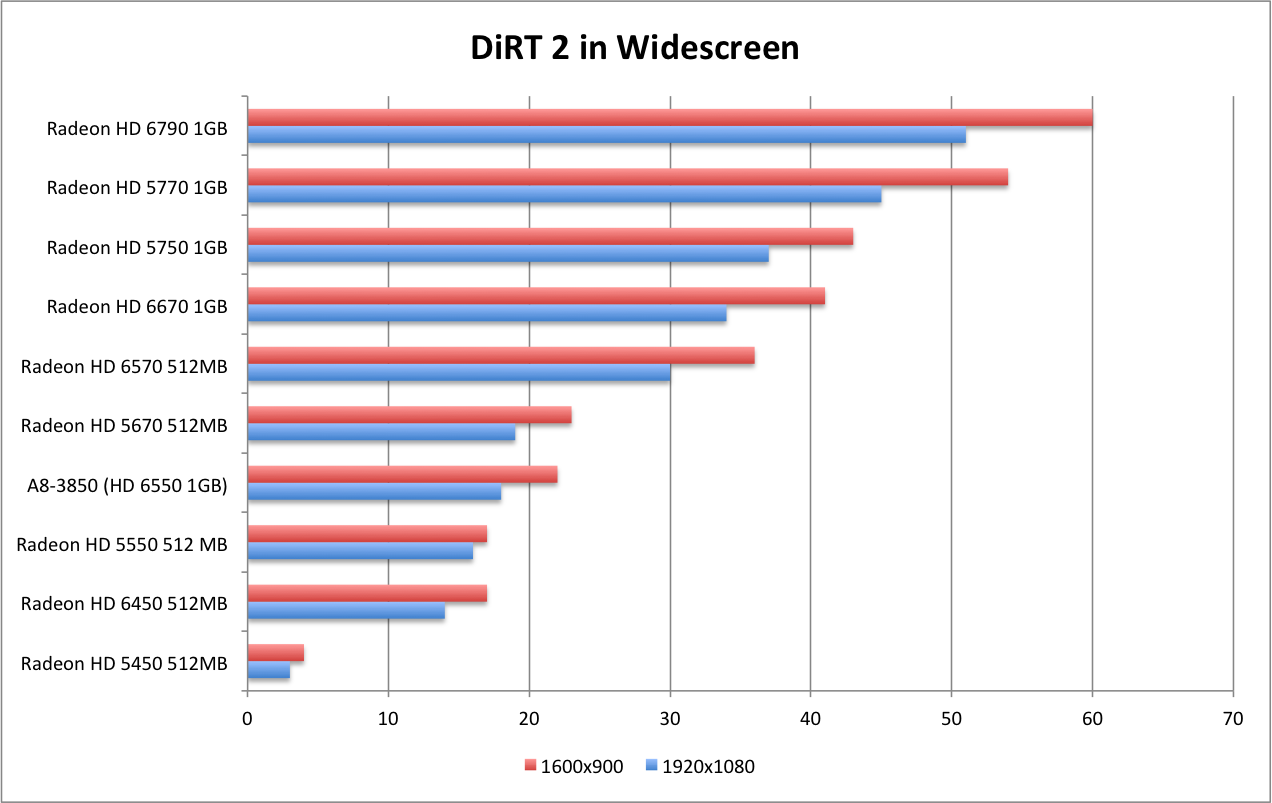
AMD Radeon 6670, 6570 & 6450 Review - F1 2010, Far Cry 2 & H.A.W.X.
F1 2010
F1 (Formula 1) is a relatively new racing title from Codemasters. Like their previous title (DiRT 2), F1 makes extensive usage of DX11 technology with cloth, fluid dynamics and tessellation. The title is much more strenuous on both single screen and Eyefinity, compared to DiRT 2. The HD 6670 is the first card to provide acceptable frames. Additionally it's interesting to note that the F1 2010 engine tends to be less demanding than Dirt 2, even though the game was produced by the same company and was released later.
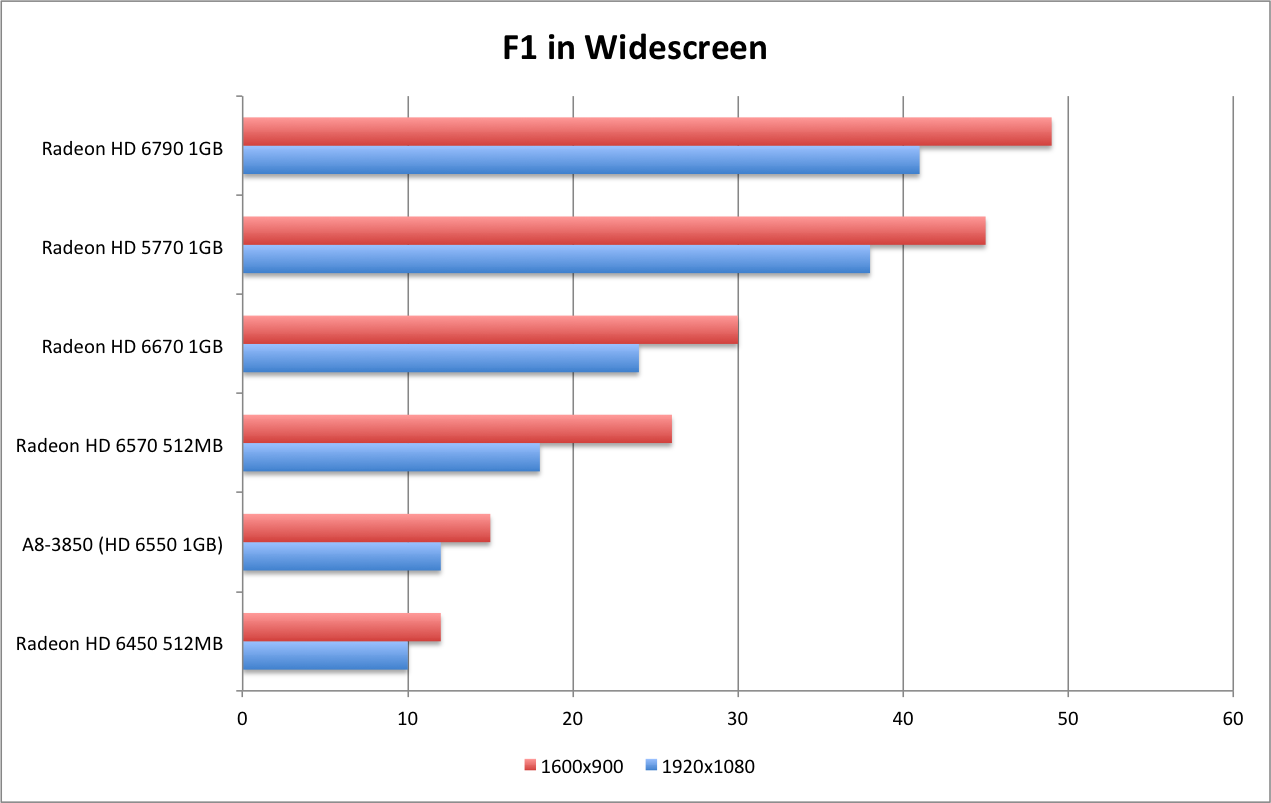
Far Cry 2
Far Cry 2 (and the whole Cry/Crysis series) has long been considered a system killer. If not a killer, then at least a good strong test. As always, we run our test at max settings with 4xAA. The benchmark tool within Far Cry 2 offers settings for High, Very High and Ultra. We chose Ultra with 4xAA.
While once a true system killer, Far Cry 2 shows that hardware catches up to software. The HD 6570 pushes past 30fps at 1600x900, and the HD 6670 pushes past at 1080p. All in all good performance for this class of cards.
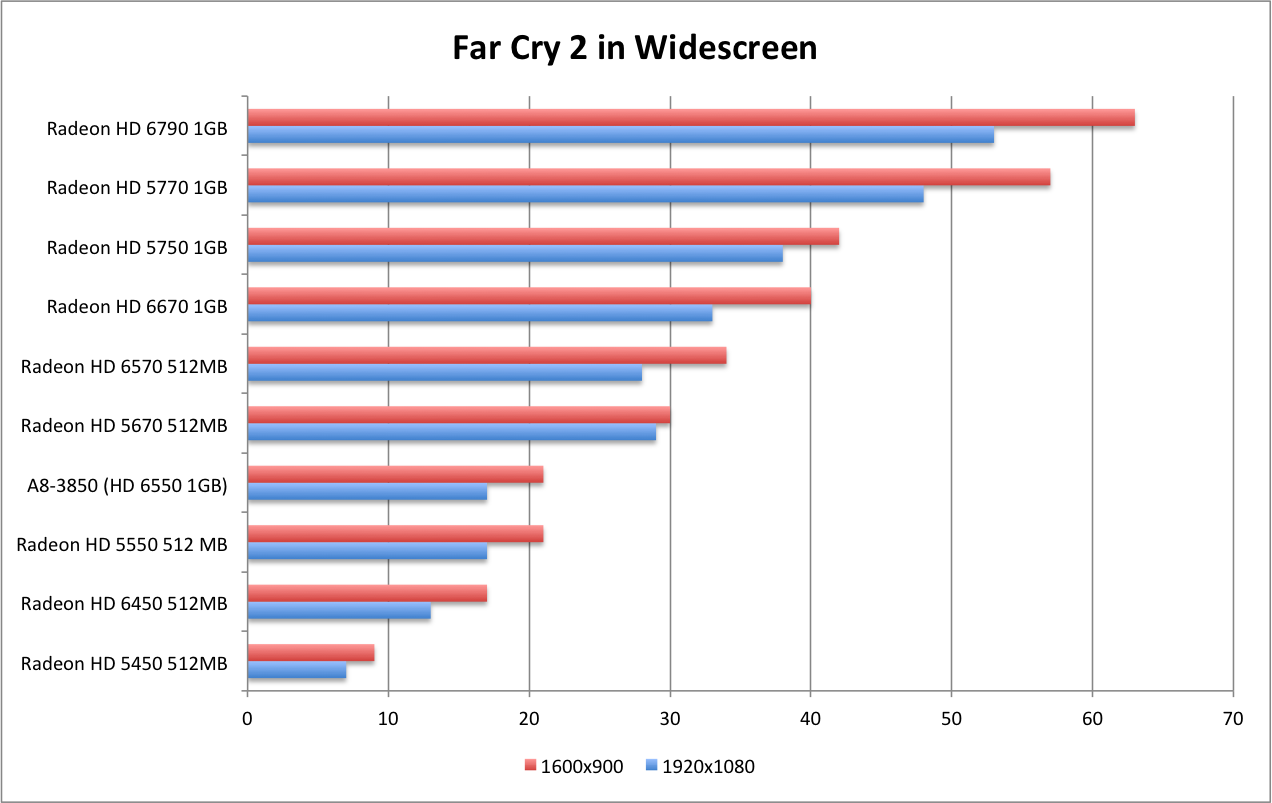
H.A.W.X.
H.A.W.X. is one last title that AMD has been showing off since the Radeon 5000 line launched. While the other titles are Hor+ and offer cutting-edge DX11 features, HAWX is quite the opposite. While it is a Hor+ title, it is only a DX10 title and runs quite well on a wide variety of hardware.
The well running and scalable title makes it a natural fit when showcasing both lower-end hardware pushing three panels, and high-end hardware pushing six panels. It also comes as no surprise that the additional VRAM largely goes unused, considering the title runs capably on lower hardware.
One note in the HAWX benchmark. Above 1920x1080 the game simply would not allow 4xAA. While the scores provide that the title could handle it, the option simply is not available. Though it isn't our norm, we chose to accept 2xAA so that we could get consistent readings across the spectrum of hardware. Both the HD 6570 and HD 6670 produce playable frames at 1080p.
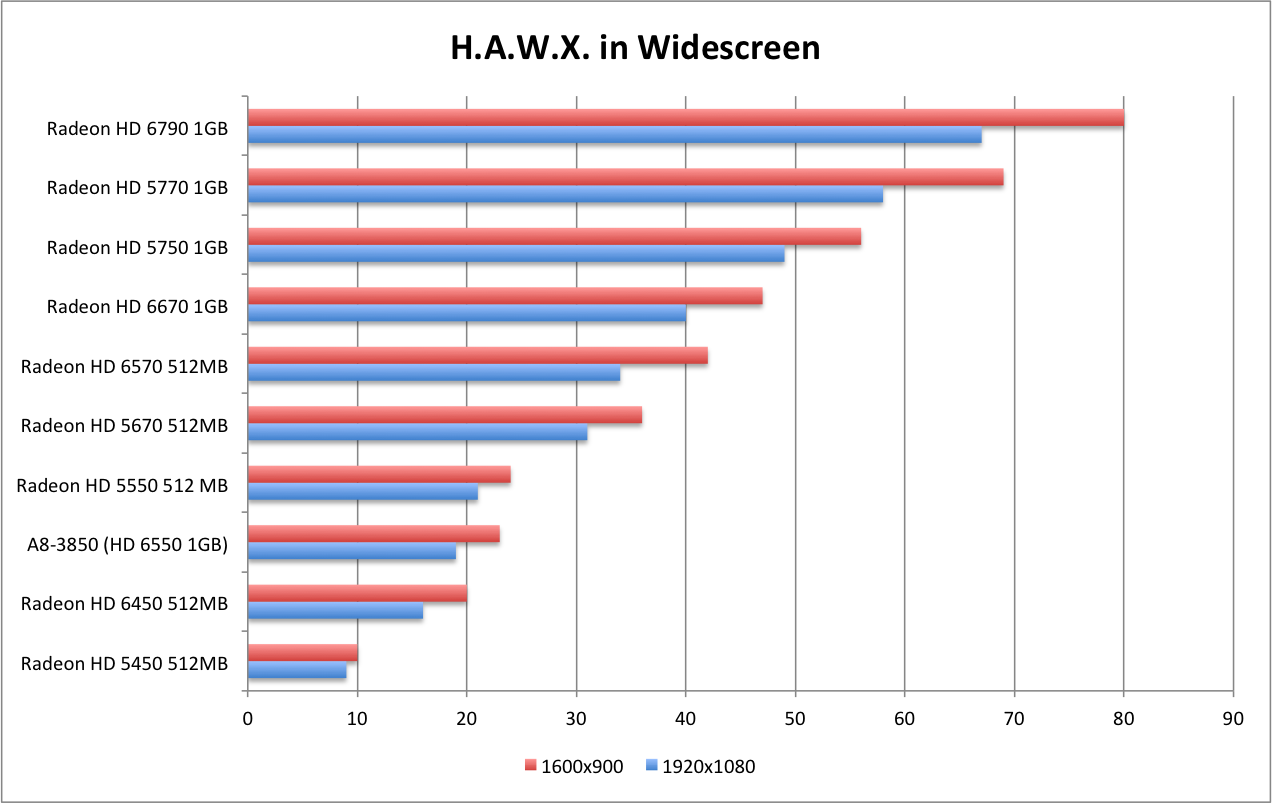
AMD Radeon 6670, 6570 & 6450 Review - Heaven Demo v2 (Dx9, DX10 & DX11)
Heaven Demo v2
The Unigine Heaven Demo is unique in that it is the only demo which allows for the following components in one package.
- Synthetic Demo (i.e., a demo designed to "test" a system)
- Comparable tests of DX9, DX10 and DX11
- Is Hor+ (rather than limited to a few predefined aspect ratios)
The ability to compare DX9, DX10 and DX11 in the same environment allows for the unique ability to see how the different cards perform across these different comparable environments. Tessellation was set at Normal Mode.
The updated 2nd version of the Heaven demo offers more segments and more options. As we've seen in the past, the Mainstream cards aren't designed to handle the Heaven demo at full-bore.
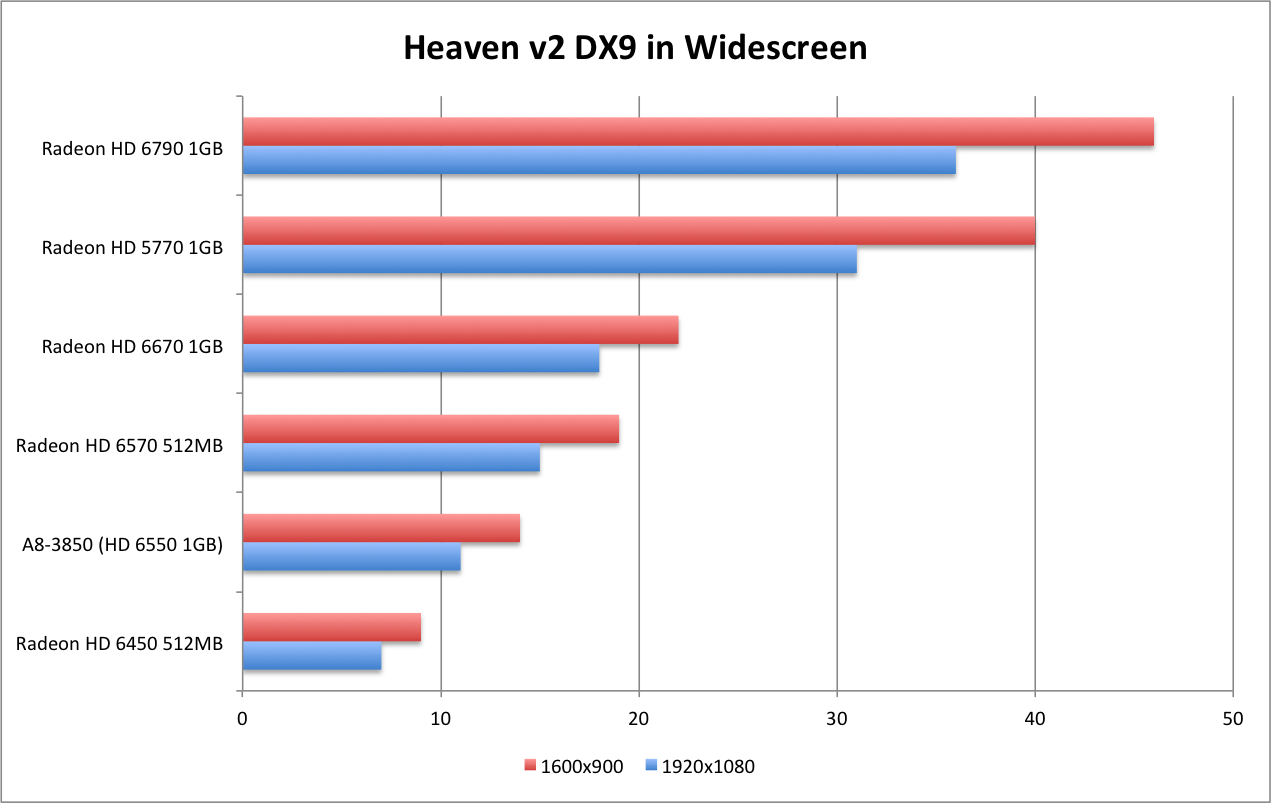
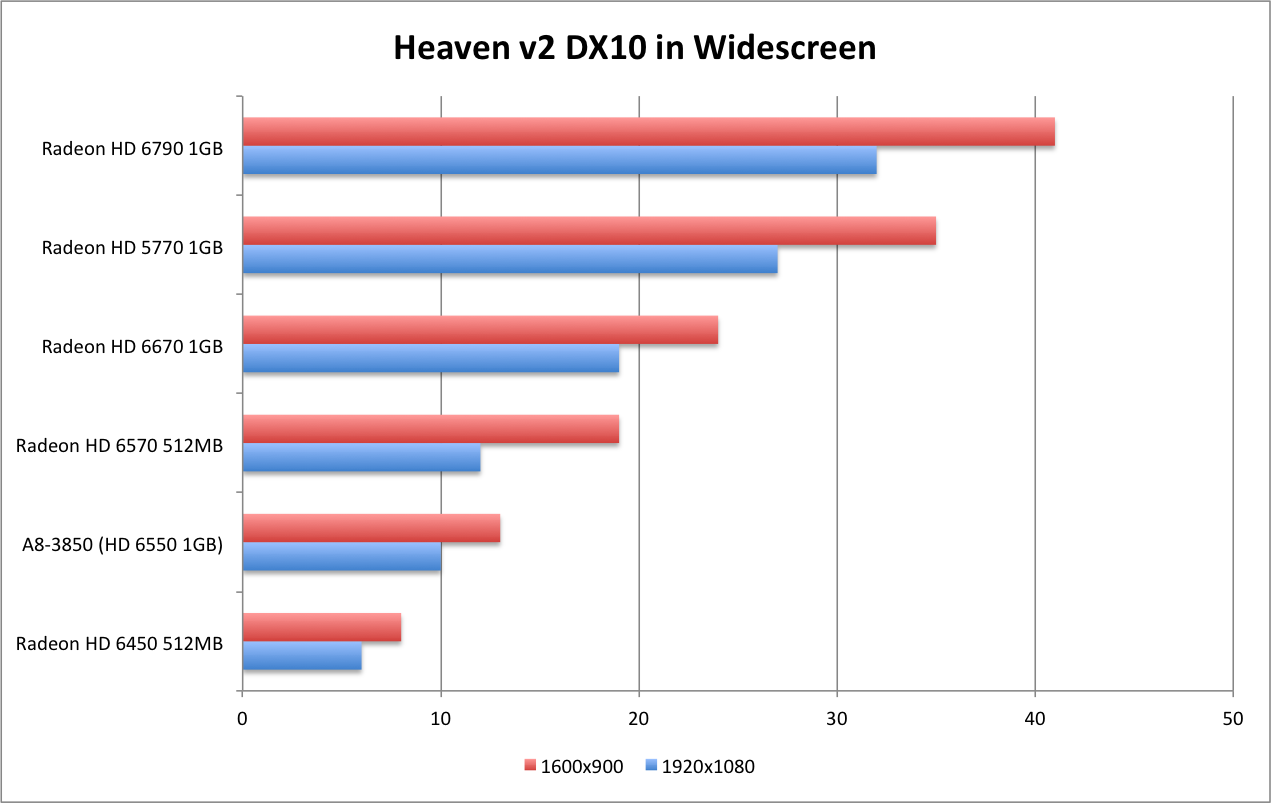

AMD Radeon 6670, 6570 & 6450 Review - Just Cause 2 & Mafia II
Just Cause 2
Just Cause 2 is the wildly popular sequal to the wildly popular Just Cause. You take control of protagonist Rico Rodriquez and rain down over the top destruction across a small desert island. The game is a free roaming title that offers literally limitless options to wreck havoc with your "hook shot" grappling device.
While the benchmark tool in the demo doesn't offer anything in the way of explosions or destruction, it does offer some beautiful scenery that is still quite demanding on multi-monitor environments. The HD 6570 and 6670 both push to 30fps, at max settings.
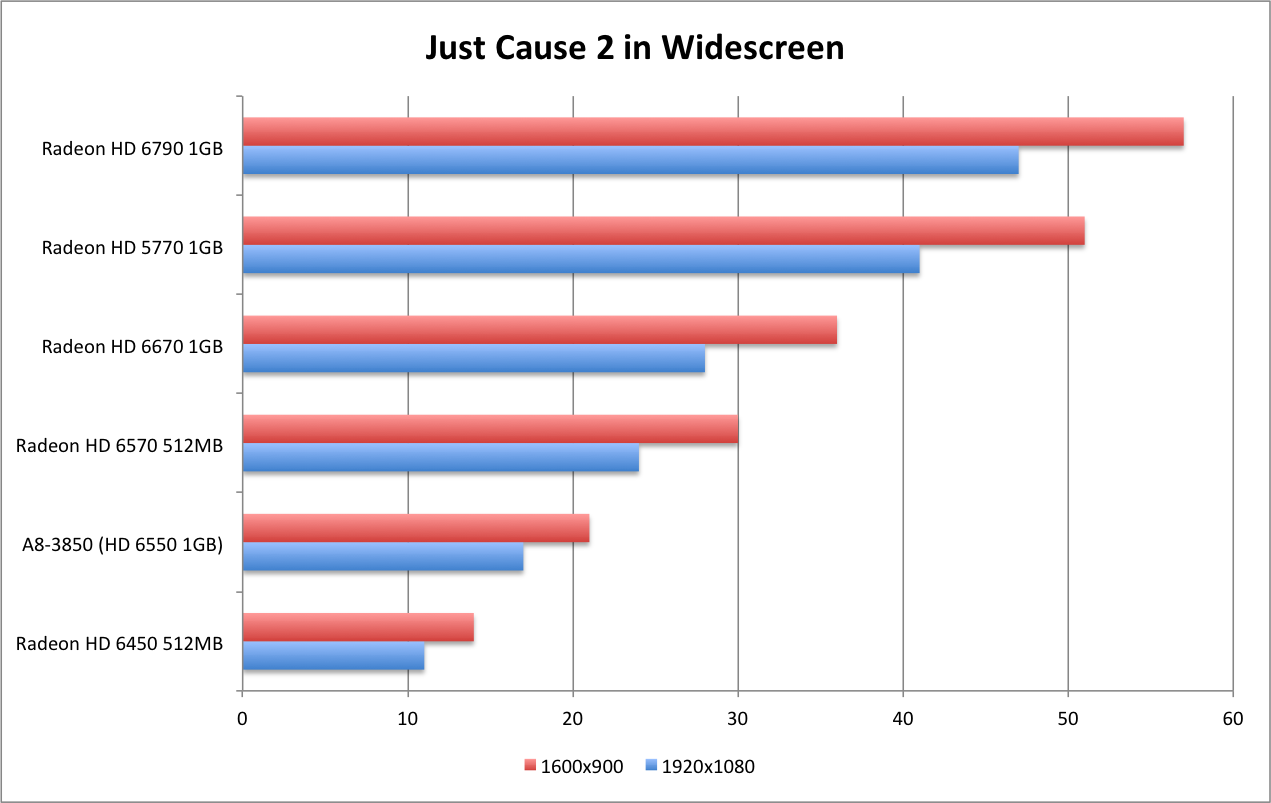
Mafia II
Mafia II is an open world "crime" title from 2K Games. It is the second game in the Mafia series. The demo comes with a built-in benchmark tool that offers both indoor and outdoor environments, various lighting effects and fire. Mafia II is quite demanding and none of the Mainstream cards approach 30fps.
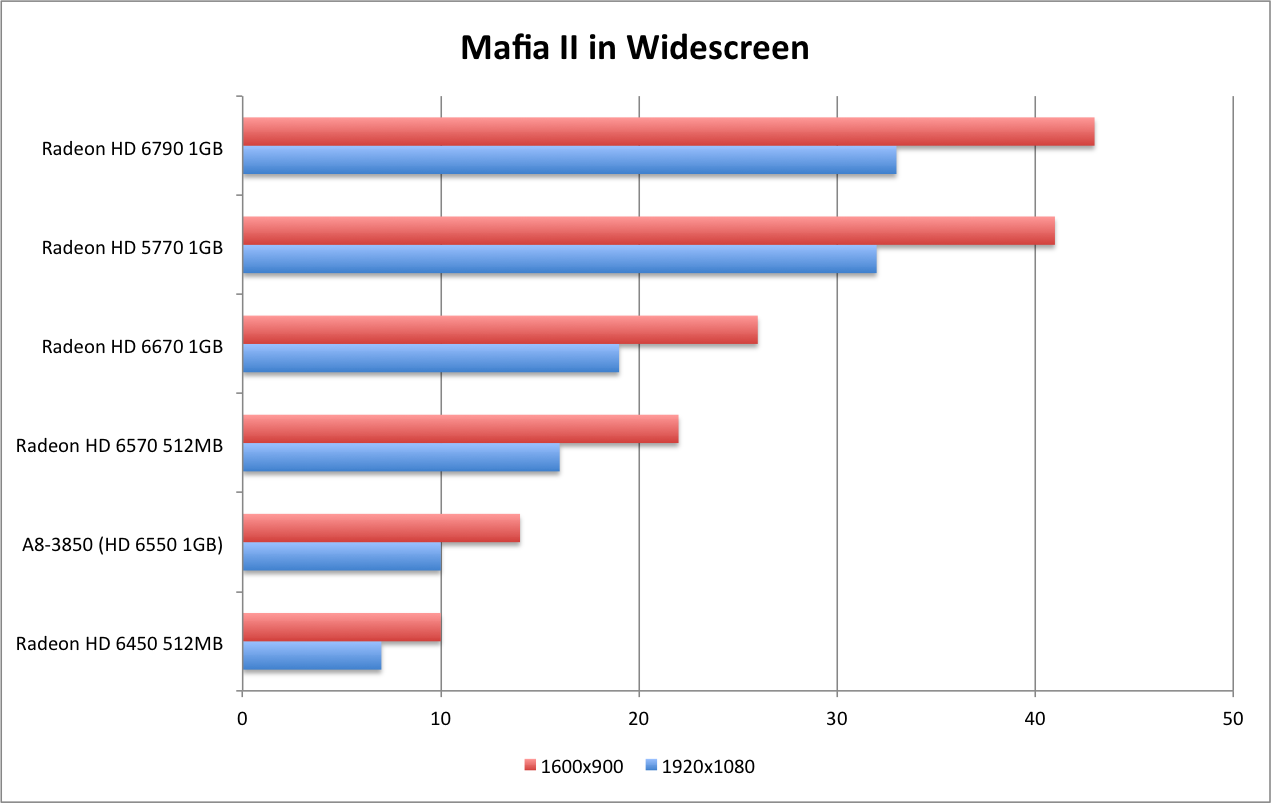
AMD Radeon 6670, 6570 & 6450 Review - S.T.A.L.K.E.R.: Call of Pripyat
S.T.A.L.K.E.R.: Call of Pripyat
Prior to the game's release, the developer put out a benchmarking tool to test your system configuration. It offers a number of different options for utilizing DX9, 10 or 11 code paths. It also offers options for varying levels of HDAO and Shadow Quality. The demo itself isn't very pretty to look at (lots of dirt and dirt-colors), but it does put a beating on your system.
While none of these cards provides playable frame rates, we can see the improvements over the previous generation. The HD 6450 will actually run the benchmark, and the HD 6670 shows improvements on the order of 50%. In many instances the HD 6670 outperforms the HD 5750, and that card required an external power connector.
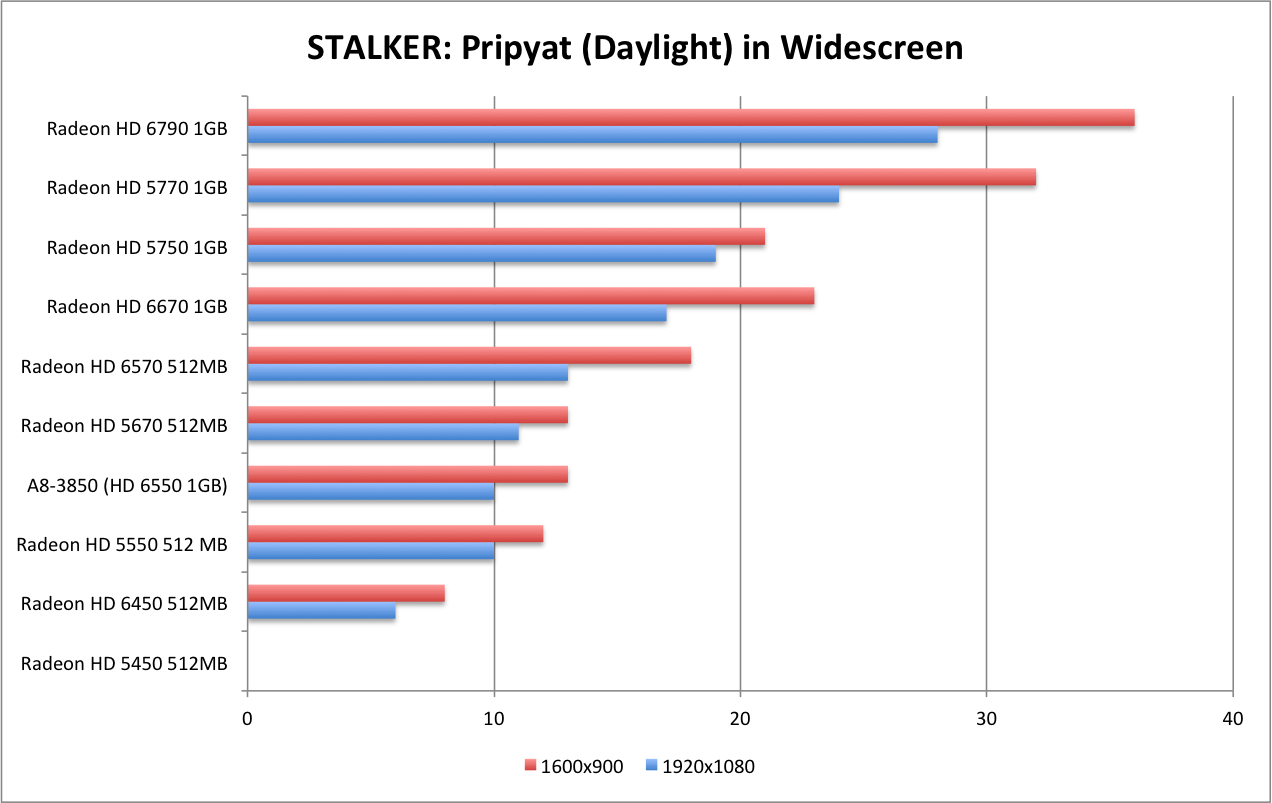
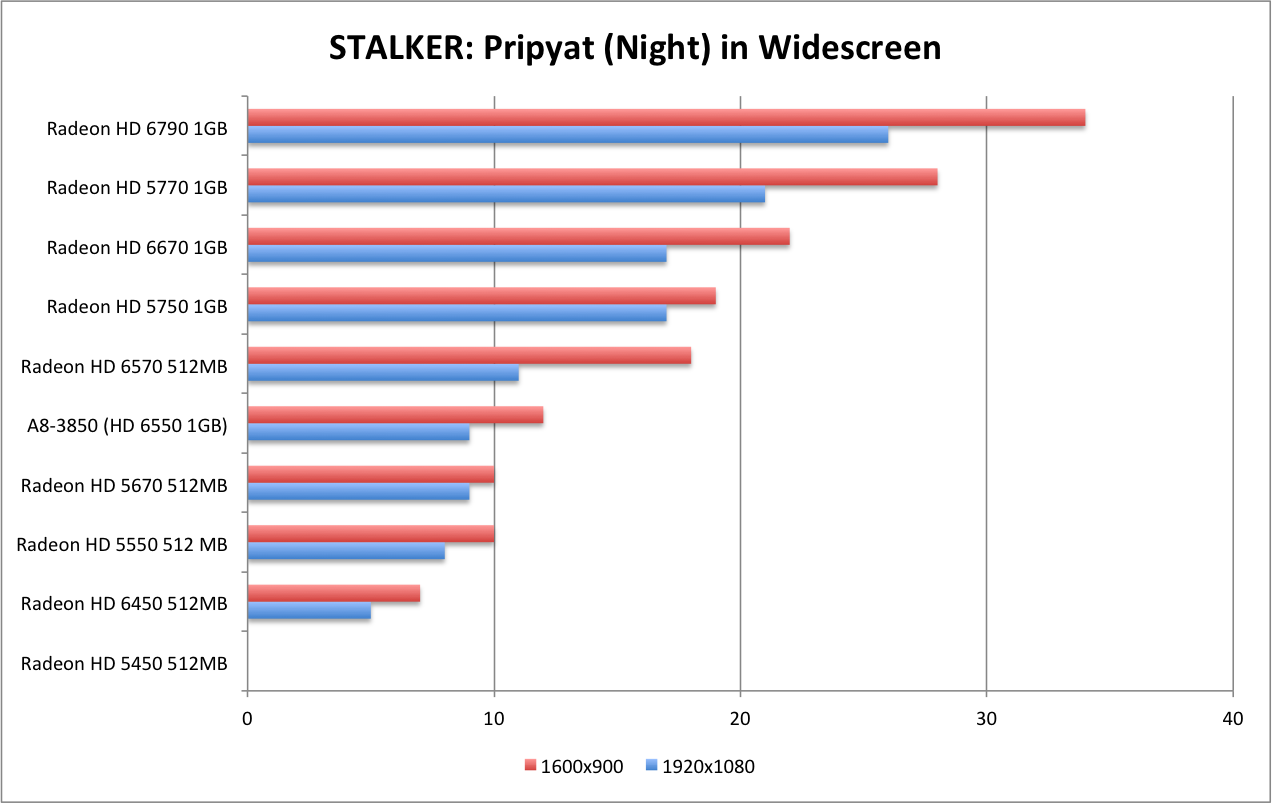
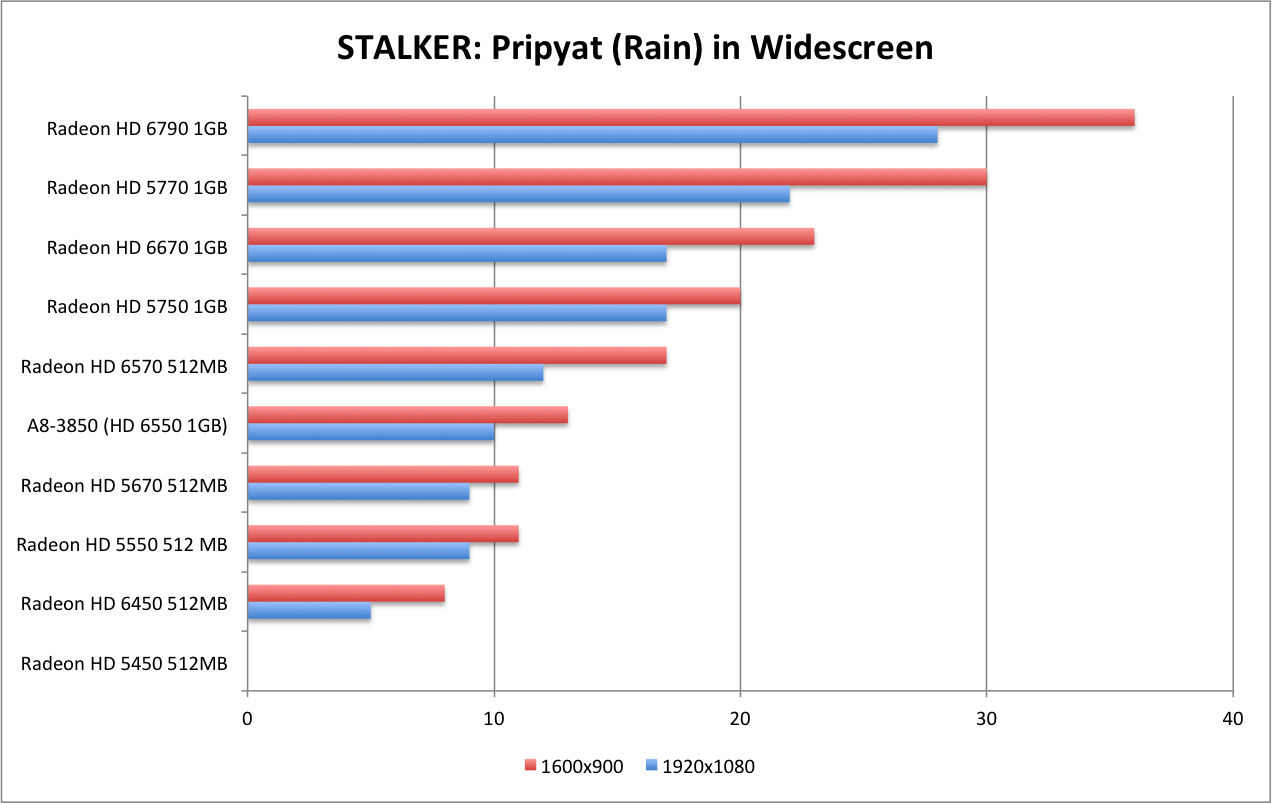
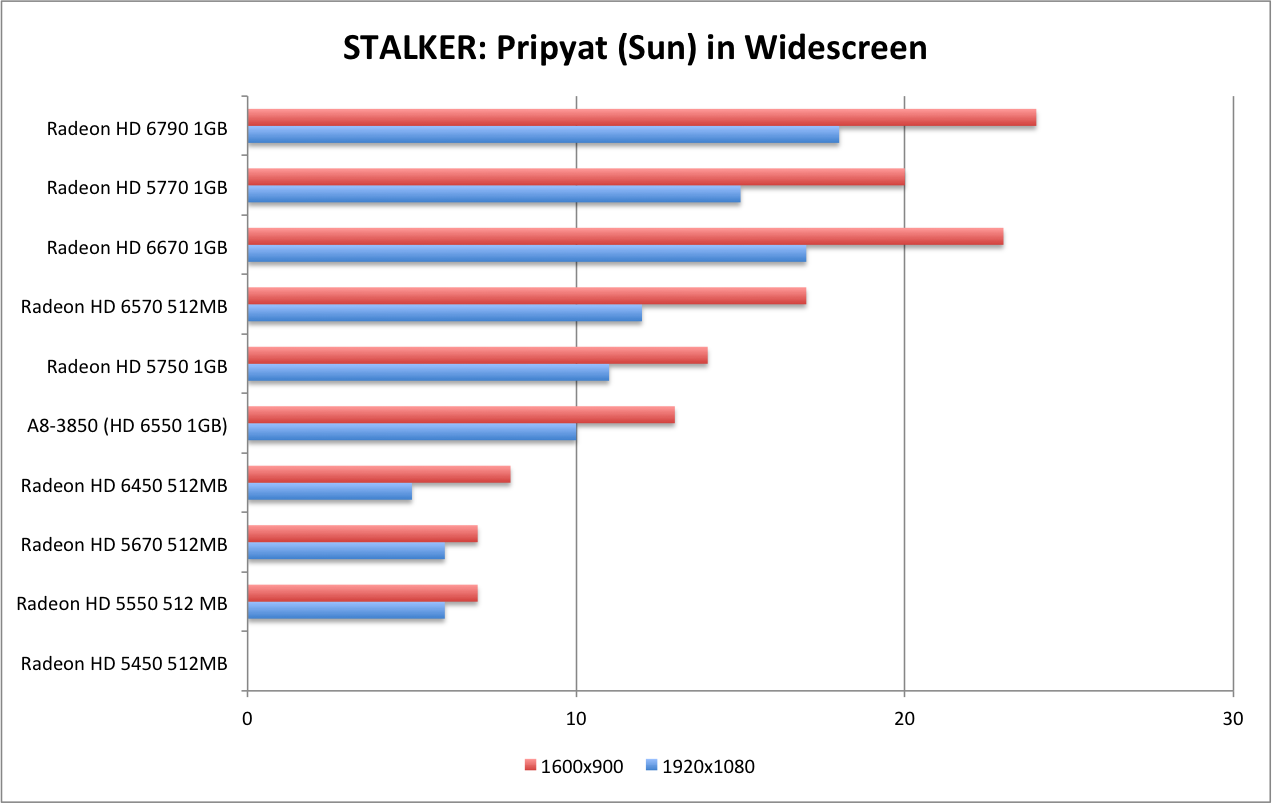
AMD Radeon 6670, 6570 & 6450 Review - Conclusions
Hitting 30/60
What they are doing is providing a better experience for the large mainstream segment of the computer-owning populace... and doing so with a much smaller power draw and a smaller price tag over their predecessors.
The only card with a real shot of hitting 30fps or 60fps is the HD 6670. It hits 30fps at 1080p in Dirt 2, Far Cry 2 and H.A.W.X. Additionally, it comes close in F1 2010 and Just Cause 2, hitting 30fps at 1600x900. With a little bit of tweaking you can hit 30fps in most titles. I didn't go through the work to determine the settings in each game on the HD 6670, but I did find that 30fps is possible on virtually every title using Medium settings with the A8-3850 APU. This utilizes an HD 6550 core, which is far less powerful than the HD 6670.
One thing to note is that almost all of the titles played very smoothly, with minimum frames close to their average. Far Cry 2 had it's jitteriness, and the Heaven Demo was particularly demanding. For everything else I'm confident that the mild bit of tweaking would provide not only an average of 30fps in most titles, but maintain a minimum above 30fps.
Final Thoughts
These cards aren't going to run away with any performance awards, but they weren't designed to. What they are doing is providing a better experience for the large mainstream segment of the computer-owning populace. I wouldn't recommend an HD 6450 for anyone who plays anything more than Angry Birds or Plants vs. Zombies. Having said that, the HD 6450 is improved over the HD 5450 in that it will actually run all of the tests in our benchmark suite.
The HD 6570 and HD 6670 are decent little cards, and I would always recommend going for as much power as possible. Both cards offer solid performance boosts, and do so with a much smaller power draw and a smaller price tag over their predecessors. If you've got the money for a 1GB HD 6670 it could make a nice foundation for a 2nd PC or HTPC, especially a fan-less version. This is especially true when you consider that it often outperforms the HD 5750 which was never offered in a fan-less versions and required a 6-pin PCI-e power connection.
I haven't yet tested the HD 6770, but it's just a re-branded HD 5770 (which we have in our scores). If you want 30fps/60fps at max settings, I would recommend the HD 6790. What I do think is really interesting to watch is the performance of the HD 6570 and HD 6670, and project how this level of performance will change the computing landscape as it gets rolled into future APU releases.